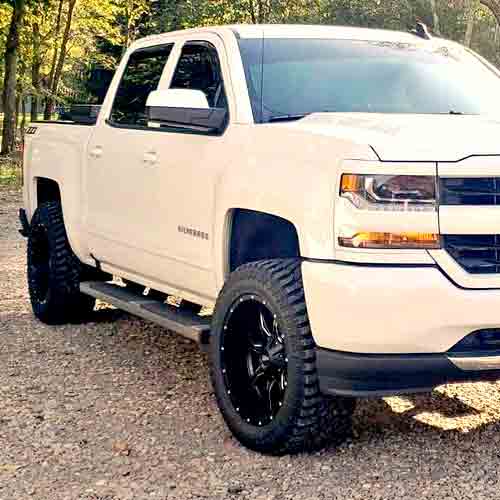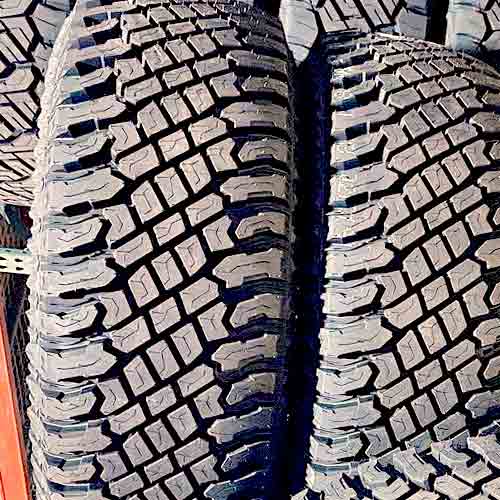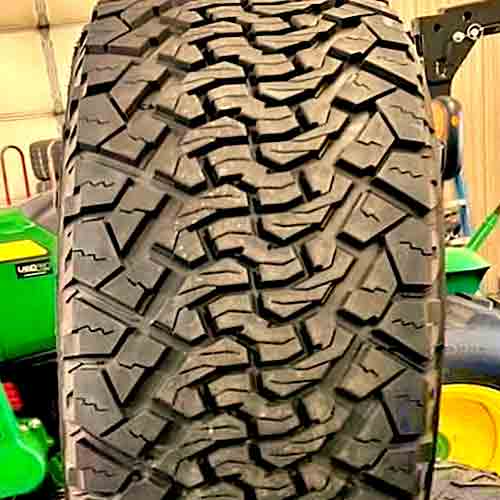Introducing the Atturo Trail Blade X/T and the Venom Terra Hunter X/T, two noteworthy hybrid tires that impress with their off-road grip and superior resistance against cuts and chips. Though these tires still promise smooth on-road navigation too. So the main question is, who does it better? Well, you’ll find it shortly.

Available Sizes
On the other hand, the Atturo Trail Blade XT comes in 30 total sizes in 17 to 24 inches with following specs.
- Speed rating: Q, S and H.
- Load rating: XL, C, D and E.
- Weight range: 30 to 84 lbs.
- Tread depth range: 13.5 to 18/32″
- Not rated with 3PMSF.
- 45,000 mile tread life warranty
On the other side, the Venom Terra Hunter XT brings you a whopping 16 to 28 inches wheels, with following specs.
- Speed rating: R, S, T, P and Q.
- Load rating: XL to F.
- Weight range: 28 to 83 lbs.
- Tread depth range in /32″: 15 to 21. Though 21 is only available in 28″.
- Not rated with 3PMSF.
- 50,000 mile tread life warranty
Tread Design
The Atturo Trail Blade X/T is a very unique tire. So let me discuss its tread here first.

So what makes this tire different from other is its lateral orientation of the lugs.
See how the squared off lugs are placed one after another between the two elongated shoulder lugs forming an asymmetric tread design.
This type of design basically creates a paddle effect on loose terrains, such as snow, and and even a little bit of mud, throwing thick material backwards and creating forward momentum with it.
And at the same time, these lugs as they are packed up together, provide ample on road traction as well.
Though same can’t be said about the lateral grip, as shoulder lugs have wider spacing, with stone ejectors placement there and sharp edges, plus the aggressive biters on sidewalls, you do get amazing off-road sideways traction, that’s for sure.
On the other side, Venom Terra Hunter X/T reminds me of the KO2, mainly from the middle.

In the center, the tread features interlocking lugs, where the middle-most lug gets wrapped by the other two surrounding C shaped (if you like), lugs.
All these lugs have very sharp edges, notches, and full depth rectilinear siping.
And needless to say, they form a very interconnected web of grooves running in all directions, and offering multi-directional grip.
These blocks are separated from the shoulders, by widest running channels or circumferential grooves.
The shoulder lugs are very biting, offering bigger lug geometry, with sharper edges, combined with reinforced foundations.
Moreover, these lugs also feature very wide lateral tread voids in between, and their siping pattern is also a little different.
Tread Wear
Treadwear is governed by a combination of factors including rolling resistance, tread depth, and composition. That’s why a tire with deeper tread voids and a stiffer composition tends to have a longer lifespan.
This explains why despite its shallower tread depth, the Venom Terra Hunter XT’s harder compound does not wear as quickly as its competitor.
On the other side, with softer tread, the Atturo lacks, though its still not by a lot, as its greater tread depth helps it to last for a comparable time till it reaches down to 2/32″ (which is the legal tread depth limit, in USA).
That’s why the tire only offers 5k less miles warranty compared to its counterpart.
Dry Directional Grip
Dry grip is contingent upon the extent of the tire’s rubber that comes into contact with the road, that’s why such a grip is also called directional grip, and gets measured with braking distances.
Now, although, the Atturo Trail Blade XT features laterally oriented lugs, its tread’s closed up lug arrangement still facilitates superior dry grip relative to the competitor.
And its simply because dry grip is highly dependent on the tire’s central area, and Atturo offers a greater contact patch meet up from there.
Conversely, Venom Terra Hunter XT exhibits a slight deficit in this area, which is in alignment with our testing, that showed the tire taking 4 feet longer to stop, on average, on tests.
And looking at it’s aggressive tread design it makes sense.
Dry Lateral Traction
When assessing the sideways grip of a tire, its best to keep in mind the lug bending factor. And this factors is dependent on the weight, and the tread’s composition.
Basically, as the tire curves/turns, it’s weight gets focused on its shoulders, and if they are more susceptible to bending, though would produce a larger steering response time, which would then limit the handling.
That’s why it makes sense why the Venom Terra Hunter XT still delivers superior handling times on dry roads.
The tire despite having similar shoulder footprint, compared to its counterpart, still gets to offer 2 seconds faster lap times, thanks to it’s lighter inner and outer construction, and stiffer rubber compound.
These allow for a more stable turnig of the tire, where you get a superior under and oversteering balance.
The Atturo Trail Blade, on the other hand, lacks with its larger weight which cause greater lug bending, contributing to slower handling feedback.
Wet Traction
Both tires exhibit noticeable deficiencies in wet traction. Nonetheless, if a choice must be made, the Atturo Trail Blade XT is a slightly more recommended option due to its better wet gripping features.
Now having a flexible tread has some drawbacks, but here, it yields better results for the Atturo, as it offers sipes with the needed pliability.
This then allow them to properly contract/expand, sucking up water particles with greater efficacy, and contributing to overall wet grip.
The Venom Terra Hunter XT, on the other hand, lacks slightly behind, it offers similar hydroplaning resistance compared to its counterpart.
Winter Performance
Snowy conditions present numerous variables, and while both tires perform admirably, the Atturo Trail Blade XT takes the lead, at least, that’s what our testing shows.
This tire possesses a softer compound with laterally placed lugs. Its pliable rubber compound better withstands extreme winter temperatures, and the lateral lug placement engenders a beneficial paddling effect in the snow.
However, the Venom Terra Hunter XT doesn’t fall far behind, with its full depth sipes and hook-shaped lugs providing substantial traction in winter conditions.
Off Road Traction
Off-road landscapes, including mud terrains, can be challenging, whereas gravel and dirt-filled roads are better suited for on-road tires. Let’s scrutinize each terrain type.
On Sandy Dunes
In sandy conditions, tire pressure is usually decreased to ensure flotation. And there are some tire features which help to that.
That’s why here, the Venom Terra lacks due to its stiffer sides, which besides with lowered air pressure, still get to be more susceptible to sinking.
In comparison, the Trail Blade XT, despite being heavier, has a larger average section width. In other words, its weight gets distributed very nicely, and the tire floats better.
Moreover, its laterally arranged lugs create a “paddling” effect with the sand, offering superior forward momentum.
(That’s actually what’s going on with paddle tires).
On Muddy Terrains
On this terrain type, you have to avoid tread getting clogged up with mud. As mud to mud contact is very slippery, and can’t generate any traction.
That’s why here, the Atturo Trail Blade XT with closed up tread voids, gets to lack, comparatively.
In contrast, the Venom Terra Hunter XT offering an enhanced network of grooves that connect larger voids between the shoulder lugs, offer much better mud evacuation abilities.
Moreover, the tire’s thicker lugs provide effective mud scooping to generate superior forward momentum.
On Rocky Trails
Although the Atturo Trail Blade X/T proves satisfactory on rocky terrains, it doesn’t offer as much of a lateral traction as its counterpart.
But why this traction is important in the first place?
Well, because lower lateral grip increases the propensity for sideways slippage, posing a potential risk of overturning.
That’s why the Venom Terra Hunter XT, offering a better combination of vertical and horizontal grip show superior results.
Its sidewall lugs and staggered margins deliver exceptional bite, particularly at reduced air pressure, while its hook-shaped central lugs offer grip in all directions.
Fuel Economy
The fuel consumption of a vehicle arises from rolling resistance, which is relatively higher in the Atturo Trail Blade XT.
Let me expalin why.
The tire’s greater weight implies more energy is expended in propelling a heavier structure, which is an elementary principle.
Moreover, its softer tread compound causes lugs to bend more, which consumes extra energy.
And yes, its greater tread depth, also add to that bending of the blocks, wasting energy, as that energy could have been used in to the rolling of the tire.
On the contrary, the Venom Terra Hunter XT, despite its aggressive design, maintains superior fuel efficiency due to its firmer lug placement.
Comfort On-Road
To evaluate the overall ride quality, two key factors are considered – tread noise and the tire’s capacity to handle road irregularities through its tread design and structure. Each of these aspects will be examined in more detail.
Tread Noise
Among both tires, the Atturo Trail Blade XT presents a quieter design.
Let me explain why.
As a tire rolls, air in the grooves, starting pumping in and out of the tread. And this allows for air particles to collide with the tread walls, and the impact is what creates tread noise.
Now with the lateral orientation of lugs on the Trail Blade X/T, these air particles do not impact as forcefully as they do on the Venom Terra Hunter XT.
In other words, its grooves are better streamlined for incoming air, allowing most of it to exit from the other end of the shoulders.
(This is ideally seen on directional tires).
On the other hand, the Venom Terra Hunter XT, with its relatively wider shoulders, allows air to collide with full force, generating greater decibels during testing.
On-Road Vibrations
A tire’s comfort level is determined by its ability to manage road imperfections. So softer the tire, the better it would mitigate road shocks.
That’s why the Trail Blade XT with its pliable tread, delivers superior performance in this aspect. Whereas on the Venom Terra Hunter XT, you get to have a slightly stiffer ride, where besides its harder compound, its internal stiffer plies contribute to it the most.
So what’s the verdict?
Well both tires show very different results in various condition types.
The Atturo Trail Blade XT offers superior dry grip, better wet traction, and performs well in winter conditions and sandy terrains.
Whereas, on the other hand, the Venom Terra Hunter XT excels in fuel economy, tread wear, and performs admirably in muddy and rocky terrains.